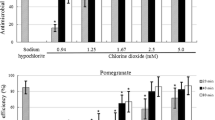Abstract
The effectiveness of Sodium dichloroisocyanurate as a disinfectant for micropropagated plants was assessed. Analysis of the microbial flora of micropropagated plants showed a wide range of bacteria with predominantly Pseudomonas, Xanthomonas and Actinomycetes. Sodium dichloroisocyanurate was highly stable both as preprepared tablets and as solutions maintained at room temperature. Sterilisation of a range of plants which were heavily contaminated with bacteria was examined. Phytotoxicity was generally low and restricted to old leaves and cut surfaces. Solutions of Sodium dichloroisocyanurate were more effective at high concentrations (5000 ppm) than a commercially available bleach for disinfection of shoot cultures. Sodium dichloroisocyanurate was also used at low concentrations (300 ppm) for longer periods (24 h–48 h) to disinfect shoot explants from the field, and was at least as effective for sterilisation as a combination of Mercuric Chloride and Calcium hypochlorite.
Similar content being viewed by others
Abbreviations
- NaDCC:
-
Sodium Dichloroisocyanurate
References
Constantine DR (1986) Micropropagation in the commercial environment. In: Withers LA and Alderson PG (eds) Plant Tissue Culture and Its Agricultural Applications
Blake J (1988) Mites and thrips as bacterial and fungal vectors between plant tissue cultures. Acta Horticulturae 225: 163–166
Enjalric F, Carron MP and Lardet L (1988) Contamination of primary cultures in tropical areas: the case of Havea brasiliensis. Acta Horticulturae 225: 57–66
Leggat I, Waites WM, Leifert C and Nicholas J (1988) Characterisation of micro-organisms isolated from plants during micropropagation. Acta Horticulturae 225: 93–102
Trick I and Lingens F (1985) Aerobic spore-forming bacteria as detrimental infectants in plant tissue cultures. Appl. Microbial Biotechnology 21: 245–249
Falkiner FR (1988) Strategy for the selection of antibiotics for use against common bacterial pathogens and endophytes of plants. Acta Horticulturae 225: 53–56
Abdul-Baki AA (1974) Hypochlorite and Tissue Sterilisation. Planta 115: 373–376
Marousky FJ (1977) Control of bacteria in Gysophila vase water. Proc. Fla. State Hort. Soc. 90: 294–299
Pink DAC and Walkey DGA (1984) Rapid propagation of Cucurbita pep. L. by culture of meristem tips. Sci. Hortic. 24 (2): 107–114
Murashige T and Skoog F (1962) A revised medium for rapid growth and bioassays with tobacco tissue cultures. Physiologia Plantarum 15: 473–497
Lloyd G and McCown BH (1989) Commercially feasible micropropagagation of mountain laurel (Kalmia latifolia) by use of shoot tip culture. Proceedings of the International Plant Propagation Society 30: 420–427
Leifert C, Waites WM and Nicholas JR (1989) Bacterial contaminants of micropropagated plant cultures. Journal of Applied Bacteriology 67: 353–361
Leifert C, Waites WM, Camotta H and Nicholas JR (1989) Lactobacillus plantarum; a deleterious contaminant of plant tissue cultures. Journal of Applied Bacteriology 67: 363–370
Leifert C, Camotta H, Wright SM, Waites B, Cheyne VA and Waites WM (1991) Elimination of Lactobacillus plantarum, Coryenbacterium spp, Staphylococcus saprophyticus and Pseudomonas paucimobilis from micropropagated Hemerocallis, Choisya and Delphinium cultures using antibiotics. J. Applied Bacteriology 71: 307–330
Coates DA (1985) A comparison of sodium hypochlorite and Sodium Dichloroisocyanurate products. J. of Hospital Infection 6: 34–36
Pevalek-Kozlina B (1991) Clonal propagation of common oak (Quercus robur L.). Acta Horticulturae 289: 143–144
The Sigma-Aldrich Library of Chemical Safety Data. Edition II. Volume 2. Lenga RE (ed) Sigma Aldrich Corporation. Poole, Dorset, UK
Saldick J (1975) Biodegradation of cyanuric acid. Applied Microbiology 28 (6): 1004–1008
Cook AM, Beilstein P, Grossenbacher H and Hutter R (1985) Ring Cleavage and degradative pathway of cyanuric acid in bacteria. Biochem. J. 231: 25–30
Herman EB (1990) Non-axenic plant tissue culture: Possibilities and opportunities. Acta Horticulturae 280: 233–238
Author information
Authors and Affiliations
Rights and permissions
About this article
Cite this article
Parkinson, M., Prendergast, M. & Sayegh, A.J. Sterilisation of explants and cultures with sodium dichloroisocyanurate. Plant Growth Regul 20, 61–66 (1996). https://doi.org/10.1007/BF00024060
Issue Date:
DOI: https://doi.org/10.1007/BF00024060




